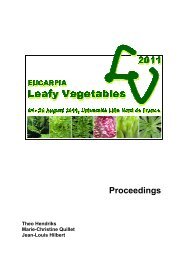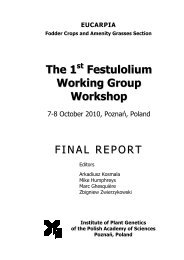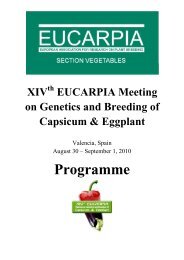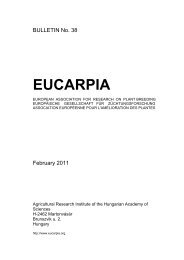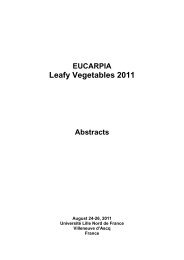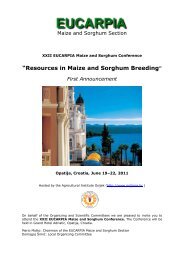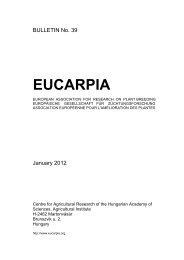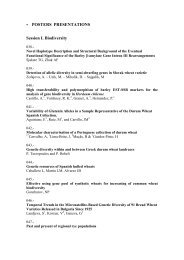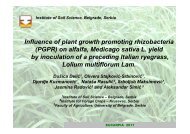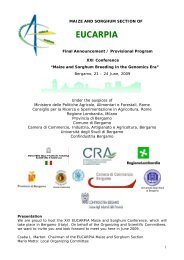Plant breeding for organic and sustainable, low-input agriculture
Plant breeding for organic and sustainable, low-input agriculture
Plant breeding for organic and sustainable, low-input agriculture
Create successful ePaper yourself
Turn your PDF publications into a flip-book with our unique Google optimized e-Paper software.
Heritability <strong>and</strong> genotype x environment interactions of mineral nutrient<br />
concentration in wheat grown in <strong>organic</strong> systems<br />
Kevin M. Murphy 1 , Julie C. Dawson 1 , Philip G. Reeves 2 , Stephen S. Jones 1<br />
1 Department of Crop <strong>and</strong> Soil Sciences, Washington State University; 2 USDA-ARS, Gr<strong>and</strong><br />
Forks Human Nutrition Research Center, Gr<strong>and</strong> Forks ND, USA.<br />
Increasingly, consumers cite personal health as the most important reason <strong>for</strong> buying <strong>organic</strong><br />
food. Selection <strong>for</strong> increased mineral concentration in wheat dem<strong>and</strong>s a working knowledge of<br />
the inheritance of the traits in question <strong>and</strong> an underst<strong>and</strong>ing of genotype x environment<br />
interactions that influence the mean trait value. This paper will focus on the nutritional value of<br />
<strong>organic</strong> wheat using calcium (Ca), copper (Cu), iron (Fe), magnesium (Mg), manganese (Mn),<br />
phosphorus (P), selenium (Se), <strong>and</strong> zinc (Zn) as response variables. We will report results of the<br />
genotype x environment analysis of variance, estimations of the genetic correlation among<br />
minerals <strong>and</strong> between locations, <strong>and</strong> the heritability of mineral concentration in <strong>organic</strong> systems.<br />
We tested sixty-three spring wheat cultivars that ranged in release date from 1842 to 2001 <strong>for</strong><br />
grain yield <strong>and</strong> mineral nutrient concentration of Ca, Cu, Fe, Mg, Mn, P, Se <strong>and</strong> Zn in <strong>low</strong>-<strong>input</strong><br />
agronomic conditions. In addition, we estimated the heritability of Ca, Cu, Fe, Mg, Mn, P, Se<br />
<strong>and</strong> Zn in ten winter wheat populations (high x high, high x <strong>low</strong>, <strong>low</strong> x <strong>low</strong>) in two locations in<br />
certified <strong>organic</strong> conditions <strong>for</strong> the F2 through the F5 generations.<br />
While grain yield has increased in the modern cultivars, mineral nutrient concentration has<br />
decreased significantly in modern cultivars <strong>for</strong> all minerals except Ca. The decrease in mineral<br />
concentration over time is found primarily in the soft white wheat market class, while the hard<br />
red market class has remained largely constant. This suggests that plant breeders, through<br />
intentional selection of <strong>low</strong> ash concentration in soft white wheat cultivars, have contributed to<br />
the decreased mineral nutrient in modern wheat cultivars. These results contradict the theory<br />
that there exists a genetically based, biological trade-off between yield <strong>and</strong> mineral<br />
concentration. Moderate to high narrow-sense heritability estimates using parent-offspring<br />
regression <strong>for</strong> each mineral suggested the dominance of additive gene action. Analysis of<br />
variance showed significant interactions <strong>for</strong> genotype x environment <strong>for</strong> all minerals tested.<br />
However, significant rank correlations among parental genotypes <strong>and</strong> populations suggest that<br />
the genotype x environment interactions are due primarily to scalar interactions rather than<br />
genotypic rank changes. There<strong>for</strong>e, using the abundant variation present in wheat cultivars, plant<br />
breeders should be able to increase mineral concentration in modern cultivars without negatively<br />
affecting yield.<br />
50




